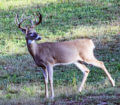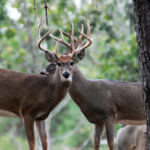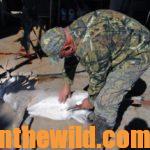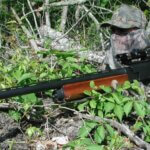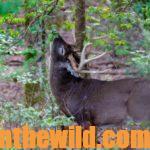Editor’s Note: If the South has another winter like the last couple of ones, southern hunters and perhaps other deer hunters across the U.S. will have to change their deer-hunting tactics. Or, they’ll continue to eat and sleep more in their deer stands. What do you do when the woods have too-much food in them, and the temperatures climb high causing the deer to refuse to move? Many deer hunters below the Mason-Dixon Line have faced this problem the last couple of years, with scientists reporting that winter has lasted 3 fewer weeks than usual across the U.S.
 Hot-weather hunting often means only a 15- 20 minute hunt. If deer do leave a thicket, they won’t go far or remain there for long. Deer like variety in their diets and will eat about 300 various kinds of food. Even though the woods may be loaded with acorns, because deer browse, they also will eat some greenbrier, the leaves on blackberry bushes, poke sallett and other green, leafy plants and grasses. My friend, Alan Benton of McDonough, Georgia, explains how to identify which oak trees will pay off in deer sightings. “This year in 2017 plenty of food has been available for the deer with our hunting region having tons of acorns all over the place. This area had so many acorns that a hunter almost would slide around on the acorns like they were marbles. A hurricane came through the place I hunt back in September and knocked numbers of acorns out of the trees, just before early bow season. The deer didn’t have to move very far to feed. The deer could bed down, stand up, walk 30 yards, feed on acorns and then return to bed down again. So, our hunting area didn’t see the amount of deer movement we ordinarily would then.
Hot-weather hunting often means only a 15- 20 minute hunt. If deer do leave a thicket, they won’t go far or remain there for long. Deer like variety in their diets and will eat about 300 various kinds of food. Even though the woods may be loaded with acorns, because deer browse, they also will eat some greenbrier, the leaves on blackberry bushes, poke sallett and other green, leafy plants and grasses. My friend, Alan Benton of McDonough, Georgia, explains how to identify which oak trees will pay off in deer sightings. “This year in 2017 plenty of food has been available for the deer with our hunting region having tons of acorns all over the place. This area had so many acorns that a hunter almost would slide around on the acorns like they were marbles. A hurricane came through the place I hunt back in September and knocked numbers of acorns out of the trees, just before early bow season. The deer didn’t have to move very far to feed. The deer could bed down, stand up, walk 30 yards, feed on acorns and then return to bed down again. So, our hunting area didn’t see the amount of deer movement we ordinarily would then.
“Many times bowhunters make the mistake of believing that if there’s a good acorn crop where they’re hunting that patterning deer should be easy. However, if your hunting area has a large acorn crop, just the opposite may be true. The deer don’t have to move much to find food. Under these conditions, the way to see deer is to pick a tree the deer historically have liked to feed under in an area where deer prefer to stay. I look first for bedding places and then for acorn trees under which the deer like to feed that are closest to their bedding. Identifying those certain trees and making notes of which trees the deer like to feed under most also is information that will help you in a bad year when where you hunt has an acorn crop failure. So, I make notes about the deer’s favorite oak trees. I’ve found that often deer prefer to feed under smaller white oak trees than they do larger white oak trees. I’ve also learned that if you plant sawtooth oaks, the deer usually will come to them first. Those acorns seem to be much like candy to the deer. However, the majority of the oaks on the properties I hunt are white oaks. I’ve learned that sometimes the deer like to feed under a white oak tree that may be only as big as the steering wheel on your truck. Of course, there are no absolutes in deer hunting.
 “However, I also have some white oak trees on some of my hunting properties that are giant trees – probably 200 years old – under which the deer like to feed. What I’ve learned is that the more I know about each property I hunt, the easier I can pick out specific oak trees where the deer like to feed each year. I believe that’s one of the keys for taking bucks in my section of the U.S. I’ve also learned that many of the same bucks will show-up under the same white oak trees, year after year, a fact that enables me to keep up with their size, age and antler development. I don’t know for certain that bucks prefer a certain tree to feed under, or whether the deer in an area just like to feed on that tree. I say that because many years when that tree doesn’t produce acorns, I’ll still see the same bucks in that place, even if that preferred tree isn’t producing acorns.
“However, I also have some white oak trees on some of my hunting properties that are giant trees – probably 200 years old – under which the deer like to feed. What I’ve learned is that the more I know about each property I hunt, the easier I can pick out specific oak trees where the deer like to feed each year. I believe that’s one of the keys for taking bucks in my section of the U.S. I’ve also learned that many of the same bucks will show-up under the same white oak trees, year after year, a fact that enables me to keep up with their size, age and antler development. I don’t know for certain that bucks prefer a certain tree to feed under, or whether the deer in an area just like to feed on that tree. I say that because many years when that tree doesn’t produce acorns, I’ll still see the same bucks in that place, even if that preferred tree isn’t producing acorns.
If you can pinpoint a deer trail near a thicket, you’ll have the best opportunity to catch a buck’s using that trail just at daylight and just at dark. The thickets the deer will come out of during daylight hours the most frequently will include the thickets with the least amount of hunting pressure on the lands you hunt. In most areas of the country, these thickets will be the farthest away from any road, power line or access that hunters can use.
Modern-day deer hunters have found that the GPS (global positioning system) hand-held receivers (https://www.bestreviews.guide/handheld-gps) greatly enhance their deer-hunting success. Once you locate a thicket well away from a road or any other kind of access into the deep woods, look for the trail the deer will use to go in and out through the thicket. Use the compass on your GPS or the one in your pocket to determine the direction of the prevailing wind. Then pick a tree stand site where you can set-up a stand and watch the trail.
 When you’ve located that tree, put four or five Bright Eyes thumbtacks, available in most sporting-goods stores and online, on that tree about chest-high. Mark the stand as a waypoint on your GPS. As you navigate back to your vehicle, mark four or five other waypoints to establish a route. Then save that route in your GPS. Long before daylight the next morning, go to your tree stand site by backtracking the route you’ve already established. As you watch your GPS and see that you’re moving closer to your stand site, use your flashlight to find the Bright Eyes on the tree you’ve selected for your stand. Put up your stand, and wait 45 minutes to an hour for daylight. Then watch that deer trail to possibly take a buck. You won’t have to spend but an hour in your stand before you’ll know if the buck will or won’t appear. You can return to that same stand site an hour or two before dark and plan to hunt from that same site, until you no longer can see the trail.
When you’ve located that tree, put four or five Bright Eyes thumbtacks, available in most sporting-goods stores and online, on that tree about chest-high. Mark the stand as a waypoint on your GPS. As you navigate back to your vehicle, mark four or five other waypoints to establish a route. Then save that route in your GPS. Long before daylight the next morning, go to your tree stand site by backtracking the route you’ve already established. As you watch your GPS and see that you’re moving closer to your stand site, use your flashlight to find the Bright Eyes on the tree you’ve selected for your stand. Put up your stand, and wait 45 minutes to an hour for daylight. Then watch that deer trail to possibly take a buck. You won’t have to spend but an hour in your stand before you’ll know if the buck will or won’t appear. You can return to that same stand site an hour or two before dark and plan to hunt from that same site, until you no longer can see the trail.
When hot weather occurs during deer season, and the woods home plenty of deer food, bucks won’t want to move, nor do they have to move. To take trophy bucks under these tough deer-hunting conditions, you must become much more active and mobile. You have to go after the bucks. You can’t bet on their coming to you. Since they won’t move, you must move.
To learn more about hunting deer with John E. Phillips’ Amazon Kindle eBooks, print books and Audible books (the latest Audible is “How to Hunt Deer Like a Pro”) and Nook books, click here at https://johninthewild.com/books/#deer. You can type in the name of the book and download it to your Kindle, and/or download a Kindle app for your iPad, SmartPhone or computer. For a free download on how to make jerky from venison to provide a protein-rich snack, choose “How to Prepare Venison Jerky: The Ultimate Snack Food” at johninthewild.com/free-books.


